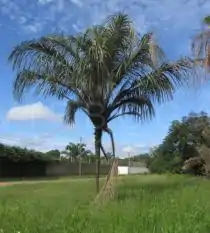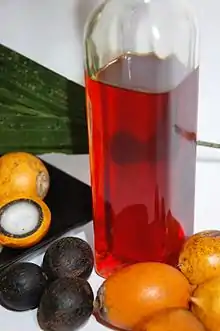Astrocaryum aculeatum
Astrocaryum aculeatum (known in Brazilian Portuguese as tucumã, acaiúra, acuiuru, coco-tucumã, tucum, tucumã-açu, tucumã-macaw, tucum-açu, tucumaí-da-terra-firme, tucumãí-uaçu, tucumã-piririca, tucumã-purupuru or tucumã-do-mato) is a palm native to tropical South America and Trinidad.[1] It grows up to 15 m (49 ft) tall and is usually solitary. It has ascending leaves, erect inflorescence, and yellow fruit.
| Astrocaryum aculeatum | |
|---|---|
 | |
| Scientific classification | |
| Kingdom: | Plantae |
| Clade: | Tracheophytes |
| Clade: | Angiosperms |
| Clade: | Monocots |
| Clade: | Commelinids |
| Order: | Arecales |
| Family: | Arecaceae |
| Genus: | Astrocaryum |
| Species: | A. aculeatum |
| Binomial name | |
| Astrocaryum aculeatum G.Mey. | |
| Synonyms[1] | |
|
Astrocaryum tucuma Mart. | |
Etymology
tucumã derives from tuku'mã in the Tupi language.[2]
Taxonomy
Astrocaryum aculeatum was first described by German botanist Georg Friedrich Wilhelm Meyer in 1818 based on a specimen from the Essequibo River in Guyana.[3]
Distribution
Astrocaryum aculeatum is found in and around the Amazon Basin, from Trinidad and Tobago in the north, through Venezuela, Guyana, Suriname, the Brazilian states of Acre, Amazonas, Pará, Rondônia, Roraima and south through the Bolivian departments of Beni, Pando, Santa Cruz.[4]
Uses
This plant has edible fruit which may be used for making a kind of wine.[5] It is also used to make a symbolic ring called a tucum ring.
A fiber is extracted from the leaves for making hammocks and ropes that resist salt water.[2]
Oil

The fruit of tucumã is composed of a woody core almost black in color, containing the white paste of the seed (colloquially called an almond in Brazil) and covered with a yellow-orange pulp. Two types of oils are produced from this fruit: the oil of the external pulp and the almond oil.[6]
The oil extracted from the pulp contains 25.6% saturated fatty acids and 74.4% unsaturated fatty acids composed of palmitic, stearic, oleic, and linoleic acids. It can be used as an emollient. The value of beta-carotene (which is 180 to 330 milligrams/100g oil) is more concentrated in the oil than in the pulp.[7]
| Fatty acid composition of the oil Tucumã (Pulp) | |
|---|---|
| Palmitic | 27,7% |
| Oleic | 65,67% |
| Linoleic | 3,65% |
| Linolenic | 4,97% |
Cosmetic industry
The tucuma pulp oil could in the future be used to manufacture soap, body lotions or hair care products.[7]
Physico-chemical data
| Index | Unity | Reference values |
| Free fatty acids | % | 1.4562 |
| Refractive Index | - | 1.4562 |
| Index of Iodine | gl2 / 100g | 82 |
| Saponification value | mg KOH / g | 188.4 |
| Materia unsaponifiable | % | 1,4 |
| Acidity | mgKOH / g | 2.58 |
| Index of Peroxide | meq / kg | 1.72 |
| Density | g / L | 0.982 |
| Melting | °C | 27-35 |
References
- Astrocaryum aculeatum Royal Botanic Gardens, Kew: World Checklist of Selected Plant Families.
- Ferreira, A. B. H. Novo dicionário da língua portuguesa. Segunda edição. Rio de Janeiro. Nova Fronteira. 1986. p. 1724, 1725
- Bernal, Rodrigo (2008). "(1837) Proposal to conserve the name Astrocaryum aculeatum (Palmae) with a conserved type". Taxon. 57 (3): 997–998.
no
- Kahn, Francis (2008). "The genus Astrocaryum (Arecaceae)" (PDF). Revista Peruvana de Biología. 15 (supl. 1): 31–48. ISSN 1727-9933.
no
- Calvacante, P. B.: Frutas Comestíveis da Amazônia, 1996, 6a Ed , Edições Cejup - Museu Paraense Emílio Goeldi, Belém.
- Pesce, Celestino. Oleaginosas da Amazônia. –Belém: Museu Paraense Emilio Goeldi, 2009.
- Bora, P. S. et. al.: Characterization of the oil and protein fractions of tucuma (Astrocaryum vulgare Mart) fruit. 2001, Ciencia y Technologia Alimentaria, Ourense, Espanha, v. 3, n. 2, p. 111-116.
- Morais, L. : Banco de Dados Sobre Espécies Oleaginosas da Amazônia, unpublished and unavailable online.